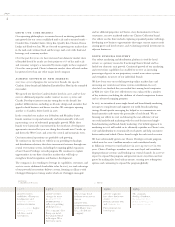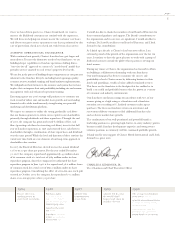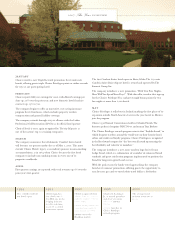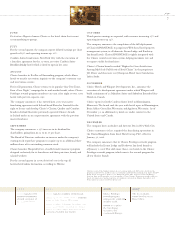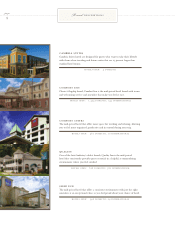Comfort Inn 2007 Annual Report Download - page 15
Download and view the complete annual report
Please find page 15 of the 2007 Comfort Inn annual report below. You can navigate through the pages in the report by either clicking on the pages listed below, or by using the keyword search tool below to find specific information within the annual report.
prior to the two-for-one stock split effected in October 2005) of common stock at a total cost of $895.9 million since the
program’ s inception. Considering the effect of the two-for-one stock split, the Company has repurchased 71.5 million
shares at an average price of $12.52 per share. Our cash flows from operations support our ability to complete the
repurchase of approximately 3.2 million shares remaining as of December 31, 2007 under the current authorization of our
board of directors. Subject to market and other conditions and upon completion of the current authorization, our board of
directors will evaluate the propriety of additional share repurchases. In 2007, we paid cash dividends totaling
approximately $40.1 million and we presently expect to continue to pay dividends in the future. Based on our present
dividend rate and outstanding share count, aggregate annual dividends for 2008 would be approximately $42.0 million.
The principal factors that affect the Company’ s results are: the number and relative mix of franchised hotel rooms;
growth in the number of hotel rooms under franchise; occupancy and room rates achieved by the hotels under franchise;
the effective royalty rate achieved; and our ability to manage costs. The number of rooms at franchised properties and
occupancy and room rates at those properties significantly affect the Company’ s results because our fees are based upon
room revenues at franchised hotels. The key industry standard for measuring hotel-operating performance is revenue per
available room (“RevPAR”), which is calculated by multiplying the percentage of occupied rooms by the average daily
room rate realized. Our variable overhead costs associated with franchise system growth have historically been less than
incremental royalty fees generated from new franchises. Accordingly, we expect that continued growth of our franchise
business will enable us to realize benefits from the operating leverage in place and improve operating results.
The Lodging Industry(1)
Companies participating in the lodging industry primarily do so through a combination of one or more of the three
primary lodging industry activities: ownership, franchising and management. A company’ s relative reliance on each of
these activities determines which drivers most influence its profitability.
• Ownership requires a substantial capital commitment and involves the most risk but offers high returns due to
the owner’ s ability to influence margins by driving RevPAR and managing operating expenses. The ownership
model has a high fixed-cost structure that results in a high degree of financial leverage. As a result, profits
escalate rapidly in a lodging up-cycle but erode quickly in a downturn as costs rarely fall as fast as revenue.
Profits from an ownership model increase at a greater rate from RevPAR growth attributable to average daily
rate (“ADR”) growth, than from occupancy gains since there are more incremental costs associated with higher
guest volumes compared to higher pricing.
• Franchisors license their brands to a hotel owner, giving the hotel the right to use the brand name, logo,
operating practices, and reservations systems in exchange for a fee and an agreement to operate the hotel in
accordance with the brand standards. Under a typical franchise agreement, the hotel pays the franchisor an initial
fee, a percentage-of-revenue royalty fee and a marketing/reservation reimbursement. A franchisor’ s revenues are
dependent on the number of rooms in its system and the top-line performance of those hotels. Earnings drivers
include RevPAR increases, unit growth and effective royalty rate improvement. Franchisors enjoy significant
operating leverage in their business model since it costs little to add a new hotel franchise to an existing system.
Franchisors normally benefit from higher industry supply growth, because the benefits of unit growth usually
outweigh lower RevPAR resulting from excess supply. As a result, franchisors benefit from both RevPAR
growth and supply increases which aids in reducing the impact of lodging industry economic cycles.
• Management companies operate hotels for owners that do not have the expertise and/or the desire to self-
manage. These companies collect management fees predominately based on revenues earned and/or profits
generated. Similar to franchising activities, the key drivers of revenue based management fees are RevPAR and
unit growth and similar to ownership activities, profit based fees are driven by improved hotel margins and
RevPAR growth.
(1) Certain industry statistics included in this section, such as the number of hotel rooms, number of affiliated and non-
affiliated rooms, US Lodging Industry Trends From 1997 – 2007, etc. were obtained from Smith Travel Research.
13



